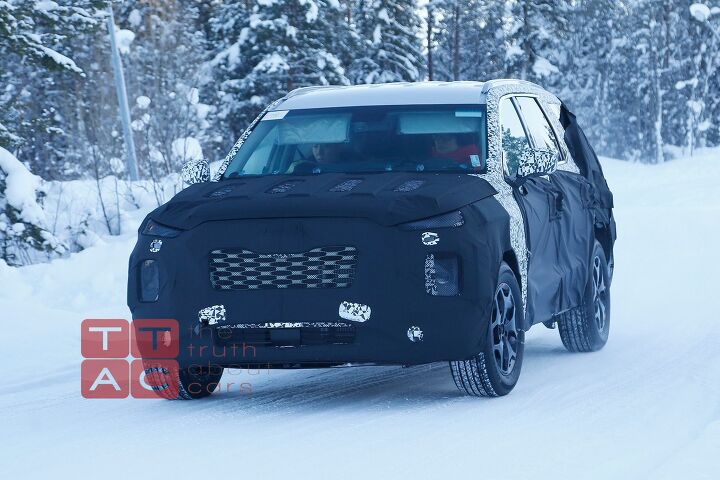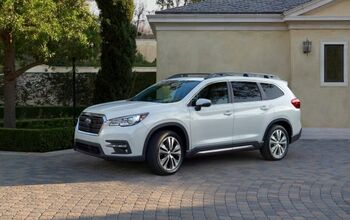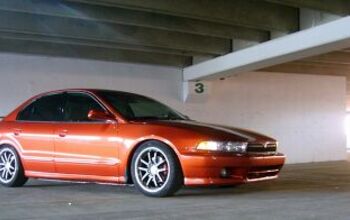When You're This Big, They Call You Grandmaster

If you’re following the Busan International Motor Show as close as we are, and we know you are, you no doubt saw the unveiling of Hyundai’s newest and largest concept vehicle, the HDC-2 Grandmaster. Sounding like an air-dropped fission weapon or perhaps an experimental jet prototype of the 1940s, Hyundai’s big, honkin’ SUV concept showcases where the company’s going with its design language.
It’s also possible you’ve seen the Grandmaster’s shape before, perhaps churning up the snow on a wintery test course in a set of spy photos.
Earlier this year, we got our hands on pics of a well-camouflaged unibody utility vehicle traipsing through the powder. The model in question, while not officially named, is expected to become the pinnacle of Hyundai’s crossover range, positioned above the Santa Fe (formerly the Santa Fe Sport) and replacing the Santa Fe XL (formerly the Santa Fe). Hyundai claims it wanted a vehicle that appeals to an American clientele, and you know what that means. Big, blunt, and imposing.
Based on a U.S. trademark application, it’s possible the range-topper will carry the “Palisade” name. Both vehicles can be seen below:
For the record (and the less cultured among us), Hyundai’s choice of “Grandmaster” for its concept relates to chess, not the fellow who hung out with the Furious Five.
Minus the oversimplified front end treatment and oversized wheels, the Grandmaster’s proportions looks pretty similar to the vehicle seen in those snowy photos, so what we’re seeing roll out in Busan is a taste of real product to come. Referring to the concept as a “blueprint for our evolved design strategy,” SangYup Lee, Vice President and head of Hyundai styling, said “we will move towards becoming a brand that customers can really relate to emotionally. Moving on from being a brand that provides a great value, we will aspire to also become a brand that is widely beloved by our customers.”
It’s no wonder why Hyundai’s new design strategy carries the tongue-tying label of “sensuous sportiness.” Who doesn’t want to be either of those things?
While full-size crossover buyers seem to prefer a brawny looking vehicle that hides the fact it lacks a ladder frame or solid rear axle (*cough* Chevy Traverse *cough*), designers delve a little deeper into the buyer’s subconscious. According to Hyundai, the concept’s styling harmonizes “four key elements – proportion, architecture, styling and technology – thereby bringing emotional value and desirability.”
Hyundai sure hopes buyers feel the pull. The automaker’s American comeback strategy hinges on the popularity of the new crossovers coming down the pipe, especially models like the Palisade(?) and revamped Santa Fe. Interestingly, it’s because of crossovers that Hyundai posted its first year-over-year monthly sales gain of 2018 in May. The automaker’s volume rose 11.5 percent last month. Credit goes to the recently-arrived subcompact Kona, which moved just over 5,000 units in March, plus modest sales increases for the Santa Fe family and Tucson.
[Images: Hyundai, Brian Williams/Spiedbilde]

More by Steph Willems
Latest Car Reviews
Read moreLatest Product Reviews
Read moreRecent Comments
- Kjhkjlhkjhkljh kljhjkhjklhkjh A prelude is a bad idea. There is already Acura with all the weird sport trims. This will not make back it's R&D money.
- Analoggrotto I don't see a red car here, how blazing stupid are you people?
- Redapple2 Love the wheels
- Redapple2 Good luck to them. They used to make great cars. 510. 240Z, Sentra SE-R. Maxima. Frontier.
- Joe65688619 Under Ghosn they went through the same short-term bottom-line thinking that GM did in the 80s/90s, and they have not recovered say, to their heyday in the 50s and 60s in terms of market share and innovation. Poor design decisions (a CVT in their front-wheel drive "4-Door Sports Car", model overlap in a poorly performing segment (they never needed the Altima AND the Maxima...what they needed was one vehicle with different drivetrain, including hybrid, to compete with the Accord/Camry, and decontenting their vehicles: My 2012 QX56 (I know, not a Nissan, but the same holds for the Armada) had power rear windows in the cargo area that could vent, a glass hatch on the back door that could be opened separate from the whole liftgate (in such a tall vehicle, kinda essential if you have it in a garage and want to load the trunk without having to open the garage door to make room for the lift gate), a nice driver's side folding armrest, and a few other quality-of-life details absent from my 2018 QX80. In a competitive market this attention to detai is can be the differentiator that sell cars. Now they are caught in the middle of the market, competing more with Hyundai and Kia and selling discounted vehicles near the same price points, but losing money on them. They invested also invested a lot in niche platforms. The Leaf was one of the first full EVs, but never really evolved. They misjudged the market - luxury EVs are selling, small budget models not so much. Variable compression engines offering little in terms of real-world power or tech, let a lot of complexity that is leading to higher failure rates. Aside from the Z and GT-R (low volume models), not much forced induction (whether your a fan or not, look at what Honda did with the CR-V and Acura RDX - same chassis, slap a turbo on it, make it nicer inside, and now you can sell it as a semi-premium brand with higher markup). That said, I do believe they retain the technical and engineering capability to do far better. About time management realized they need to make smarter investments and understand their markets better.




































Comments
Join the conversation
Korean cars suck. I dont care.
“sensuous sportiness.” I used to feel that way about Sporty Spice - wait what were we talking about?